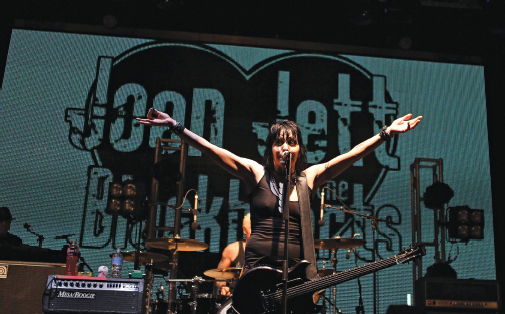Punk, Grunge, and Alternative Rock: New Genres on the Horizon
Printed Page 145
As rock and roll moved from the edges of the American music scene into the mainstream, other genres arose to take its place on the fringes. While many people had considered rock a major part of the rebel counterculture in the 1960s, in the 1970s they increasingly viewed it as part of consumer culture. With major music acts earning huge profits, rock had become just another product for manufacturers and retailers to promote, package, and profit from. According to critic Ken Tucker, this situation produced “faceless rock” performed by bands with “no established individual personalities outside their own large but essentially discrete audiences” of young white males.5 These “faceless” groups—REO Speedwagon, Styx, Boston, Journey, Kansas—filled stadiums and entertained the maximum number of people while stirring the minimum amount of controversy. It was only a matter of time before new types of music—punk, grunge, and alternative rock—arose to challenge rock’s mainstream once more. Concurrently, an older genre, country music, rose to greater prominence, crossing over to gain more mainstream acceptance.
Punk Revives Rock’s Rebellious Spirit
Punk rock arose in the late 1970s to defy the orthodoxy and commercialism of the record business. Punk attempted to revive rock’s basic defining characteristics: simple chord structures that anyone with a few guitar lessons could master, catchy melodies, and politically or socially defiant lyrics. Emerging in New York City around bands such as the Ramones, Blondie, and Talking Heads, punk quickly spread to England, where a soaring unemployment rate and growing class inequal-ity ensured the success of socially critical rock. Groups like the Sex Pistols, the Clash, the Buzzcocks, and Siouxsie and the Banshees sprang up and even scored Top 40 hits on the U.K. charts. Despite their popularity, the Sex Pistols, one of the most controversial groups in rock history, was eventually banned for offending British decorum.

Punk didn’t succeed commercially in the United States, in part because it was so hostile toward the commercialization of the mainstream music industry. However, it did help to break down the “boys’ club” mentality of rock, launching unapologetic and unadorned front women like Patti Smith, Joan Jett, Debbie Harry, and Chrissie Hynde. It also introduced all-women bands whose members not only wrote but also performed their own music. Many of these female groups made it into the mainstream. Through these and other innovations, punk reopened the door to experimentation at a time when the industry had turned music into a purely commercial enterprise.

Grunge and Alternative Reinterpret Rock
Building on the innovative spirit of punk, the grunge genre further transformed rock in the 1990s. Grunge got its name from its often messy guitar sound and the torn jeans and flannel shirts worn by its musicians and fans. Its lineage traced back to 1980s bands like Sonic Youth, the Minutemen, and Hu¨sker Du¨. In 1992, after years of limited commercial success, this younger cousin of punk finally broke into the American mainstream with the success of Nirvana’s “Smells Like Teen Spirit,” the hit single from their album Nevermind.
Some critics view punk and grunge as subcategories or fringe movements of alternative rock, even though grunge was far more commercially successful than punk. This vague label encompasses many types of experimental rock music that offered departures from the staged extravaganzas of 1970s glam rock. Such music appealed chiefly to college students and twenty-somethings and set itself apart from the sounds of Top 40 and commercial FM radio. The same is true of indie rock, a broad category of independent-minded rock music, usually distributed by smaller record labels; this genre can also be traced to 1980s punk and post-punk acts, and has achieved greater commercial success in recent years.